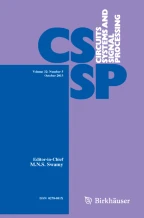Abstract
This paper mainly deals with target detecting problem using polarimetric Multiple Input Multiple Output (MIMO) radar against Spherically Invariant Random Vector (SIRV) clutter. First, we develop the MIMO signal model to two polarimetric channels and SIRV clutter-dominated scenario, and then the Generalized Likelihood Ratio Test (GLRT) is derived with known covariance structure. Meanwhile, three estimation strategies of covariance, such that Sampled Covariance Matrix (SCM), Normalized Sampled Covariance Matrix (NSCM) and Fixed Point Estimation (FPE) matrix, are introduced to make derived receiver fully adaptive. A thorough performance assessment is given by several numerical examples, and the results show that the polarimetric diversity and the spatial diversity can be exploited to improve the detection performance, and it outperforms the conventional polarimetric phased-array counterpart. Meanwhile, the FPE strategy is more suitable to implement the adaptive detection algorithm, the adaptive loss of which is completely acceptable in practical applications.
Similar content being viewed by others
References
E. Conte, A. De Maio, CFAR detection of distributed targets in non-Gaussian disturance. IEEE Trans. Aerosp. Electron. Syst. 38(2), 612–621 (2002)
E. Conte, A. De Maio, Rao test and Wald test based detection of distributed targets in non-Gaussian noise. IEEE Trans. Aerosp. Electron. Syst. 39(2), 568–582 (2003)
E. Conte, M. Longo, Modelling and simulation of non-Rayleigh radar clutter. IEE Proc. F 138(2), 121–130 (1991)
E. Conte, M. Di Bisceglie, C. Galdi, G. Ricci, A procedure for measuring the coherence length of the sea texture. IEEE Trans. Instrum. Meas. 46(4), 836–841 (1997)
A. De Maio, G. Alfano, Polarimetric adaptive detection in non-Gaussian noise. Signal Process. 83, 297–306 (2003)
A. De Maio, M. Lops, Design principles of MIMO radar detectors. IEEE Trans. Aerosp. Electron. Syst. 43(3), 886–898 (2007)
A. De Maio, G. Alfano, E. Conte, Polarization diversity detection in compound-Gaussian clutter. IEEE Trans. Aerosp. Electron. Syst. 10(1), 114–131 (2004)
A. De Maio, G. Ricci, A polarimetric adaptive matched filter. Signal Process. 81, 2583–2589 (2001)
E. Fishler, A. Haimovich, R.S. Blum, L. Cimini, D. Chizhik, R. Valenzuela, Spatial diversity in radars—Models and detection performance. IEEE Trans. Signal Process. 54(3), 823–838 (2006)
D.R. Fuhrmann, G.S. Antonio, Transmit beamforming for MIMO radar systems using partial signal correlation, in Proceedings of 38th Asilomar Conference Signals, Systems, Computers, vol. 1 (2004), pp. 295–299
S. Gogineni, A. Nehorai, Polarimetric MIMO radar with distributed antennas for target detection. IEEE Trans. Signal Process. 58(3), 1689–1697 (2010)
D. Giuli, Polarization diversity in radars. Proc. IEEE 74(2), 245–269 (1986)
F. Gini, M.V. Greco, Covariance matrix estimation for CFAR detection in correlated heavy tailed clutter. Signal Process. 82(12), 1847–1859 (2002). Special Section on Signal Process. with Heavy Tailed Distributions
A. Haimovich, R.S. Blum, L.J. Cimini, MIMO radar with widely separeted antennas. IEEE Signal Process. Mag. 25(1), 116–129 (2008)
P. Lombardo, D. Pastina, T. Bucciarelli, Adaptive polarimetric target detection with coherent radar Part I: Detection against Gaussian background. IEEE Trans. Aerosp. Electron. Syst. 37(4), 1194–1206 (2001)
P. Lombardo, D. Pastina, T. Bucciarelli, Adaptive polarimetric target detection with coherent radar. Part II. Detection against non-Gaussian background. IEEE Trans. Aerosp. Electron. Syst. 37(4), 1207–1220 (2001)
N. Lehmann, A.M. Haimovich, R.S. Blum, L. Cimini, MIMO-radar application to moving target detection in homogenous clutter, in Adaptive Sensor Array Processing Workshop at MIT Lincoln Laboratory, Waltham, MA, July (2006)
N.H. Lehmann, A.M. Haimovich, R.S. Blum, L.J. Cimini, High resolution capabilities of MIMO radar, in Proceedings of 40th Asilomar Conference Signals, Systems and Computers (2006), pp. 25–30
J. Li, P. Stoica, MIMO radar with colocated antennas. IEEE Signal Process. Mag. 24(5), 106–114 (2007)
J. Li, P. Stoica, Y. Xie, On probing signal design for MIMO radar. IEEE Trans. Signal Process. 55(6), 4151–4161 (2007)
J. Li, P. Stoica, L. Xu, W. Roberts, On parameter identifiability of MIMO radar. IEEE Signal Process. Lett. 14(12), 968–971 (2007)
L.M. Novak, M.B. Sechtin, M.J. Cardullo, Studies of target detection algorithms that use polarimetric radar data. IEEE Trans. Aerosp. Electron. Syst. 25(2), 150–165 (1989)
L.M. Novak, M.C. Burl, W.W. Irving, Optimal polarimetric processing for enhanced target detection. IEEE Trans. Aerosp. Electron. Syst. 29(1), 234–244 (1993)
H. Park, J. Li, H. Wang, Polarization-space-time domain generalized likelihood ratio detection of radar targets. Signal Process. 41, 153–164 (1995)
F. Pascal, Y. Chitour, J.P. Ovarlez, P. Forster, P. Larzabal, Covariance structure maximum-likelihood estimates in compound Gaussian noise: existence and algorithm analysis. IEEE Trans. Signal Process. 56(1), 34–48 (2008)
F. Pascal, P. Forster, J.P. Ovarlez, P. Larzabal, Performance analysis of covariance matrix estimates in impulsive noise. IEEE Trans. Signal Process. 56(6), 2206–2217 (2008)
K.J. Sangston, K.R. Gerlach, Coherent detection of radar targets in a non-Gaussian background. IEEE Trans. Aerosp. Electron. Syst. 30(2), 330–340 (1994)
L. Xu, J. Li, Iterative generalized likelihood ratio test for MIMO radar. IEEE Trans. Signal Process. 55(6), 2375–2385 (2007)
Author information
Authors and Affiliations
Corresponding author
Rights and permissions
About this article
Cite this article
Cui, G., Kong, L. & Yang, X. GLRT-based Detection Algorithm for Polarimetric MIMO Radar Against SIRV Clutter. Circuits Syst Signal Process 31, 1033–1048 (2012). https://doi.org/10.1007/s00034-011-9360-3
Received:
Revised:
Published:
Issue Date:
DOI: https://doi.org/10.1007/s00034-011-9360-3
